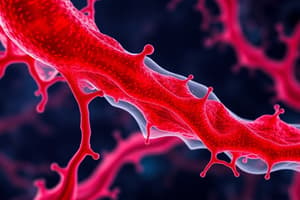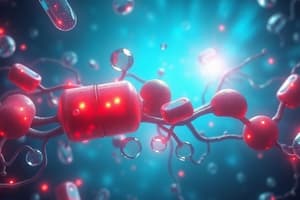Podcast
Questions and Answers
Who is credited with the discovery of the blood-brain barrier?
Who is credited with the discovery of the blood-brain barrier?
- Kristensson
- Bentivoglio
- Paul Ehrlich
- Edwin Goldmann (correct)
What is the primary function of the blood-brain barrier?
What is the primary function of the blood-brain barrier?
- To regulate blood pressure
- To allow free passage of nutrients and oxygen to neurons
- To facilitate immune system crosstalk with the nervous system
- To selectively prevent pathogens, small hydrophilic molecules, and proteins from entering the CNS (correct)
What is the purpose of the receptor theory in pharmacology?
What is the purpose of the receptor theory in pharmacology?
- To describe the action of drugs on the immune system
- To develop new strategies to overcome the blood-brain barrier
- To postulate that the action of drugs are mediated via binding to cellular structures or receptors (correct)
- To explain how the blood-brain barrier functions
What is an example of a specific disease where the blood-brain barrier is a target?
What is an example of a specific disease where the blood-brain barrier is a target?
What is the result of the blood-brain barrier being diseased?
What is the result of the blood-brain barrier being diseased?
What is the primary function of the blood-brain barrier in relation to nutrient and oxygen supply?
What is the primary function of the blood-brain barrier in relation to nutrient and oxygen supply?
Who contributed to the understanding of the blood-brain barrier with their work on trypan blue injection?
Who contributed to the understanding of the blood-brain barrier with their work on trypan blue injection?
What is the blood-brain barrier in relation to the immune and nervous systems?
What is the blood-brain barrier in relation to the immune and nervous systems?
What is the main difference between peripheral capillaries and cerebral capillaries?
What is the main difference between peripheral capillaries and cerebral capillaries?
What is the approximate length of vessels in a human brain?
What is the approximate length of vessels in a human brain?
What is the function of pericytes in the neurovascular unit?
What is the function of pericytes in the neurovascular unit?
What is the main function of astrocytes in the neurovascular unit?
What is the main function of astrocytes in the neurovascular unit?
What is the main difference between the barrier properties of peripheral endothelial cells and brain endothelial cells?
What is the main difference between the barrier properties of peripheral endothelial cells and brain endothelial cells?
What is the approximate resistance of brain capillaries?
What is the approximate resistance of brain capillaries?
What is the role of endothelial cells in the neurovascular unit?
What is the role of endothelial cells in the neurovascular unit?
What is the coverage of pericytes in the neurovascular unit?
What is the coverage of pericytes in the neurovascular unit?
Flashcards are hidden until you start studying
Study Notes
Blood-Brain Barrier (BBB)
- The BBB is a selective barrier between blood and CNS compartments that:
- Prevents pathogens, small hydrophilic molecules, proteins, and leukocytes from entering the CNS
- Allows nutrient and oxygen supply to neurons
- Regulates blood pressure
- Forms an interface for immune- and nervous system crosstalk
Structure of the Blood-Brain Barrier (BBB)
- The BBB consists of different barriers, including circumventricular organs and brain vasculature
- Brain vasculature has:
- 600 km of vessels in the human brain
- Each neuron has its own capillary
- The largest barrier interface in the brain
- Vessel composition differs between arterioles, capillaries, and venules
- Cerebral capillaries:
- Are not fenestrated like peripheral capillaries
- Have a lower transcytotic rate than peripheral endothelial cells
- Have different barrier properties (~1500-2000 Ω/cm2 vs. ~30 Ω/cm2 in peripheral capillaries)
- Have an increased number of mitochondria
- Are covered with astrocytic endfeet
- Have the highest coverage of pericytes compared to peripheral vessels
Neurovascular Unit
- The neurovascular unit consists of:
- Endothelial cells
- Pericytes/smooth muscle cells
- Astrocytes
- Neurons
- Extended parts of the neurovascular unit include:
- Microglia
- Blood cells
Pericytes
- Pericytes:
- Surround the endothelial cell layer
- Are embedded between the endothelial and parenchymal basement membrane
- Are important for the function and development of the BBB
- Influence several mechanisms in the brain (immune cell infiltration, blood flow regulation)
- Are a heterogeneous cell type dependent on vessel type
Astrocytes
- Astrocytes:
- Have direct contact with vessels, neurons, synapses, and other glial cells
- Influence tightness and transport mechanisms across the BBB
- Are essential for water and ion homeostasis in the brain (special water and ion channels at their endfeet)
- Are highly reactive after disturbance
Studying That Suits You
Use AI to generate personalized quizzes and flashcards to suit your learning preferences.




